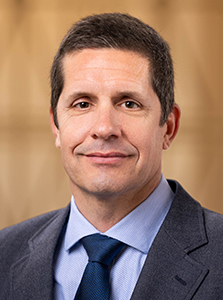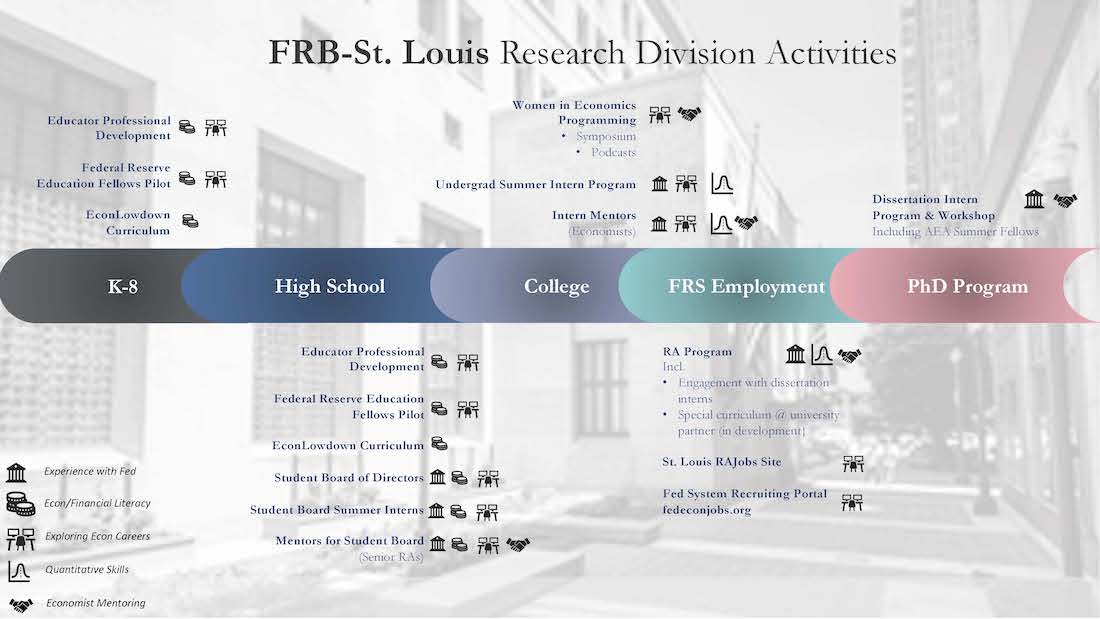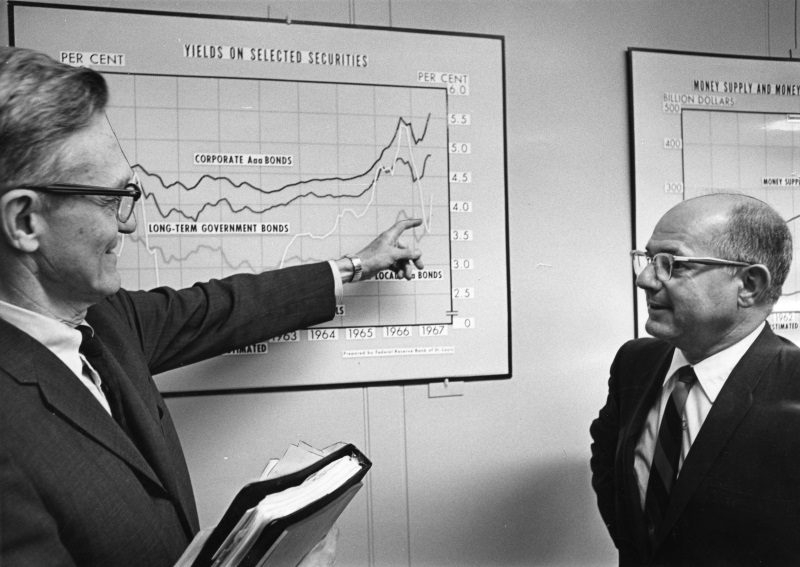
Under the leadership of research director Carlos Garriga, the Division's research economists expand the frontier of economic knowledge by producing high-quality original research in the areas of macroeconomics, money and banking, and applied microeconomics. They contribute to monetary policy discussions by advising the Bank president on a range of topics, especially in preparation for Federal Open Market Committee (FOMC) meetings.
The Research Division is in the top 1% of all economics research departments worldwide.1 The working paper series offers emerging research ideas to stimulate discussion. St. Louis Fed publications provide analysis and instruction for the general public, journalists, and students. These outlets allow Division economists to quickly and efficiently address economic trends, explore historical and current data for economic policy, and expand the understanding of issues relevant to our region, the nation, and the world.
Division leadership depends on a diversity of ideas, backgrounds, and perspectives among our economists to foster innovative thinking, expand current ideas, and reveal new areas for exploration. We recruit PhD economists on an ongoing basis. One goal of that recruiting is to continually enhance our diversity and inclusion, specifically by hiring more women and people of color. Our economic education and external communication teams are helping us accomplish this goal.
For over a decade, we have been leaders in developing a more robust pipeline—from high school to graduate school—for students to enter and excel in the field of economics: Our student board of directors program has engaged a diverse group of high school students since 2012, providing mentorship from our research associates and opportunities to experience life within the U.S. central bank. Roughly 60% of these board members are female or minority youth. Our internship programs allow us to work with and help guide a variety of students early in their careers. In our PhD intern program, priority is given to minority and female candidates, including those from the AEA Summer Fellows program. Our Women in Economics symposium and podcast series, since 2018, has highlighted the studies and careers of women who are making their mark in the field of economics.

Economists in the Research Division have a primary responsibility to conduct research. Our economists publish in numerous refereed journals and present at conferences all over the world. Economists develop their own research topics; then, in a collegial environment, they are challenged to move their ideas even further. All the necessary supports are in place to allow them to focus on what they do best—research.
Division leadership understands that the proximity of innovative thinkers can help us reach our goals. The Division hosts visiting scholars for both short-term and long-term appointments and summer dissertation interns. The Division’s research associates, who support the economists in their research, are encouraged to actively participate in this environment to develop their own skills as future economists and policy experts.
The Division sponsors and cosponsors conferences, seminars, lectures, and workshops on a wide variety of economic topics and invites economists from all over the nation and the world. The regular seminar series features the work of Division economists, visiting scholars, and invited guests.
. . .
Many other Division professional staff support the goals of the individual economists and the Division as a whole.

The St. Louis Fed’s tradition of leadership in the Federal Reserve System began decades ago with Homer Jones, the Bank’s director of research from 1958 to 1971. Under Jones and Bank president Darryl Francis, the Federal Reserve Bank of St. Louis Review became the first Federal Reserve publication to become an academic-style journal. Since 1967, this peer-reviewed publication has featured research and commentary by world-renowned economists including John Taylor, Ben Bernanke, and Christina Romer.

Homer Jones is also known for the guiding principle that everyone should be able to access data the same way a professional researcher can. He instituted popular weekly and monthly data publications that were mailed to subscribers. A 1967 Business Week article about the St. Louis Fed described the process as follows:
Jones and his people take the basic material pumped out of Washington, then rework and polish it, and put it into highly readable form. As one Fed aide in Washington observes “Homer has the most merchantable stuff coming out of the system today.”
Economists Leonall C. Andersen and Jerry L. Jordan were also well-known leaders in the Division. In 1968, they published a study in the Bank’s Review on the relationship between GNP and monetary and fiscal policy. It includes an equation (widely known as the St. Louis equation) that is still being assessed and reassessed today.
From 1975 to 1992, the Research Division was led by Anatol "Ted" Balbach, who expanded influence of the Review, enhanced databases and data publications, and launched a visiting scholar program that attracted leading economists from around the world. Learn more about the Balbach era in this 2008 Review article by Michael D. Bordo and Anna J. Schwartz.
Balbach's successor, William Dewald, appreciated the value of engaging with fellow academics and encouraged staff economists to publish research in academic journals. Dewald retired in 1998. Subsequent research directors have continued and expanded that emphasis on academic publications to reach a wider audience and inform the policy debate beyond the FOMC and immediate policy issues.
Robert Rasche was instrumental in driving the Division forward in both top-tier academic publications and services for the public: Between 1999 and 2009, he dedicated the resources needed to build up FRED’s data, spearheaded the creation of FRASER, GeoFRED, and AlFRED, and built our information resources into globally recognized services.
Chris Waller joined the Division as research director in 2009. Under his leadership, the Division continued to elevate its reputation for its leadership in monetary policy and macroeconomic research, its suite of economic information services including FRED, and its diverse and welcoming culture. In 2020, Waller was nominated and confirmed as a member of the Fed's Board of Governors, making him the first research director and second St. Louis Fed economist to go on to serve on the Board.
[1] As determined by the citation ranking tracked by the independent, volunteer-run RePEc service